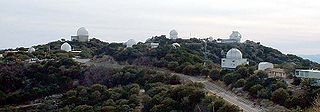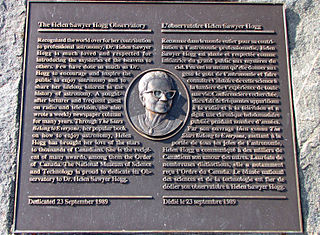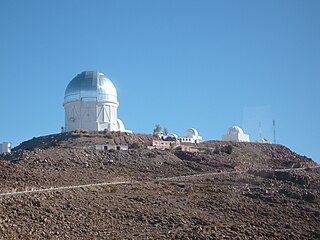Related Research Articles

The Kitt Peak National Observatory (KPNO) is a United States astronomical observatory located on Kitt Peak of the Quinlan Mountains in the Arizona-Sonoran Desert on the Tohono O'odham Nation, 88 kilometers (55 mi) west-southwest of Tucson, Arizona. With over twenty optical and two radio telescopes, it is one of the largest gatherings of astronomical instruments in the northern hemisphere.

Annie Jump Cannon was an American astronomer whose cataloging work was instrumental in the development of contemporary stellar classification. With Edward C. Pickering, she is credited with the creation of the Harvard Classification Scheme, which was the first serious attempt to organize and classify stars based on their temperatures and spectral types. She was nearly deaf throughout her career. She was a suffragist and a member of the National Women's Party.

Helen Battles Sawyer Hogg, CC was an astronomer noted for pioneering research into globular clusters and variable stars. She was the first female president of several astronomical organizations and a notable woman of science in a time when many universities would not award scientific degrees to women. Her scientific advocacy and journalism included astronomy columns in the Toronto Star and the Journal of the Royal Astronomical Society of Canada. She was considered a "great scientist and a gracious person" over a career of sixty years.

The National Optical Astronomy Observatory (NOAO) is the United States national observatory for ground-based nighttime ultraviolet-optical-infrared (OUVIR) astronomy. The National Science Foundation (NSF) funds NOAO to provide forefront astronomical research facilities for US astronomers. However, professional astronomers from any country in the world may apply to use the telescopes operated by NOAO under the NSF's "open skies" policy. Astronomers submit proposals for peer review to gain access to the telescopes which are scheduled every night of the year for observations. The combination of truly open access and the merit based science proposal process makes NOAO unique in the world.

The Cerro Tololo Inter-American Observatory (CTIO) is an astronomical observatory located on Cerro Tololo in the Coquimbo Region of northern Chile, with additional facilities located on Cerro Pachón about 10 kilometres (6.2 mi) to the southeast. It is within the Coquimbo Region and approximately 80 kilometres (50 mi) east of La Serena, where support facilities are located. The site was identified by a team of scientists from Chile and the United States in 1959, and it was selected in 1962. Construction began in 1963 and regular astronomical observations commenced in 1965. Construction of large buildings on Cerro Tololo ended with the completion of the Víctor Blanco Telescope in 1974, but smaller facilities have been built since then. Cerro Pachón is still under development, with two large telescopes inaugurated since 2000, and one in the early stages of construction.

The Horsehead Nebula is a small dark nebula in the constellation Orion. The nebula is located just to the south of Alnitak, the easternmost star of Orion's Belt, and is part of the much larger Orion Molecular Cloud Complex. It appears within the southern region of the dense dust cloud known as Lynds 1630, along the edge of the much larger, active star-forming H II region called IC 434.
The Annie Jump Cannon Award in Astronomy is awarded annually by the American Astronomical Society (AAS) to a woman resident of North America, who is within five years of receipt of a Ph.D., for distinguished contributions to astronomy or for similar contributions in related sciences which have immediate application to astronomy. The awardee is invited to give a talk at an AAS meeting and is given a $1,500 honorarium. The award is named in honor of American astronomer Annie Jump Cannon.
Emma Vyssotsky, born Emma T. R. Williams in Media, Pennsylvania was an American astronomer.
Catharine "Katy" D. Garmany is an astronomer with the National Optical Astronomy Observatory. She holds a B.S. (astrophysics), 1966 from Indiana University; and a M.A. (astrophysics), 1968, and Ph.D. (astronomy), 1971, from the University of Virginia. Catharine's main areas of research are massive stars, evolution and formation; astronomical education.
Lisa Jennifer Kewley is a Professor and Director of the ARC Centre of Excellence for All Sky Astrophysics in 3-D and ARC Laureate Fellow at the Australian National University College of Physical and Mathematical Sciences. Specialising in galaxy evolution, she won the Annie Jump Cannon Award in Astronomy in 2005 for her studies of oxygen in galaxies, and the Newton Lacy Pierce Prize in Astronomy in 2008. In 2014 she was elected a fellow of the Australian Academy of Science. In 2020 she received the James Craig Watson Medal.

The Harvard Observatory, under the direction of Edward Charles Pickering and, following his death in 1919, Annie Jump Cannon had a number of women working as skilled workers to process astronomical data.
Connie Walker (b. 1957) is an American astronomer and senior employee of the National Optical Astronomy Observatory (NOAO). She works in the NOAO's Research Based Science Education department, helping teachers develop curricula to help children learn about Astronomy. She is the director of both GLOBE at Night and Project Astro, and is a member of the board of directors of the International Dark Sky Association and the Astronomical Society of the Pacific. She was also chair of the International Year of Astronomy Dark Skies Awareness project, and continues to chair the dark skies awareness programs of Global Astronomy Month. Walker also serves on commission 50 of the International Astronomical Union.

Alicia Margarita Soderberg is an American astrophysicist who is an assistant professor of Astronomy at Harvard University and a postdoctoral fellow at the Harvard–Smithsonian Center for Astrophysics whose research focuses on supernovae.

Helen Dodson Prince was an American astronomer who pioneered work in solar flares at the University of Michigan.
Laura A. Lopez is an assistant professor of astronomy at Ohio State University studying the life cycle of stars. She was awarded the Annie Jump Cannon Award in Astronomy in 2016, which is awarded by the American Astronomical Society (AAS) for outstanding research and promise for future research by a postdoctoral woman researcher.
Emily Levesque is an American astronomer and assistant professor in the Department of Astronomy at the University of Washington. She is renowned for her work on massive stars and using these stars to investigate galaxy formation. In 2014, she received the Annie Jump Cannon award for her innovative work on gamma ray bursts. and the Sloan Fellowship in 2017 In 2015, Levesque, Rachel Bezanson, and Grant R. Tremblay published an influential paper, which critiqued the use of the Physics GRE as an admissions cutoff criterion for astronomy postgraduate programs by showing there was no statistical correlation between applicant's score and later success in their academic careers. Subsequently, the American Astronomical Society adopted the stance that the Physics GRE should not be mandatory for graduate school applications, and many graduate astronomy programs have since removed the Physics GRE as a required part of their graduate school applications.

Smadar Naoz is an Israeli-American astrophysicist, and was the 2015 winner of the Annie Jump Cannon Award in Astronomy for her scientific contributions to the fields of cosmology and planetary dynamics.
Sidney Carne Wolff is an American astrophysicist, researcher, public educator, and author. She is the first woman in the United States to head a major observatory, and she provided significant contributions to the construction of six telescopes. Wolff served as Director of the Kitt Peak National Observatory (KPNO) and the National Optical Astronomy Observatory (NOAO). She is a member of the International Astronomical Union's Division G: Stars and Stellar Physics.
Lauren Ilsedore Cleeves is an American astrophysicist and an assistant professor in the Department of Astronomy at the University of Virginia. She is specialized in the study of protoplanetary disks.
Dara J. Norman is an astronomer and the Deputy Director of the Community Science and Data Center at the National Science Foundation's National Optical-Infrared Astronomy Research Laboratory (NOIRlab) in Tucson, Arizona. She is also the Association of Universities for Research in Astronomy Diversity Advocate at NOAO. Her research centers on the influence of Active Galactic Nuclei (AGN) on the evolution of galaxies. In 2020, she was inducted into the inaugural cohort of American Astronomical Society Fellows in recognition of her leadership and achievements.
References
- ↑ "NOAO Service". National Optical Astronomy Observatory . Retrieved December 1, 2018.
- ↑ "Panelist Biographies". Chandra X-ray Observatory . Retrieved December 1, 2018.
- ↑ "Annie Jump Cannon Award in Astronomy". American Astronomical Society . Retrieved December 1, 2018.
| This United States astronomer article is a stub. You can help Wikipedia by expanding it. |